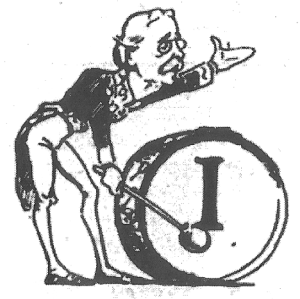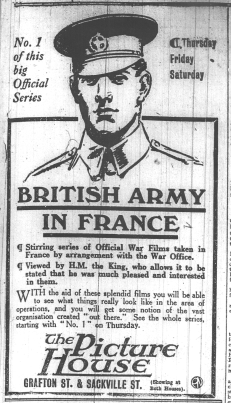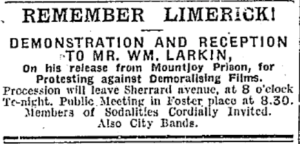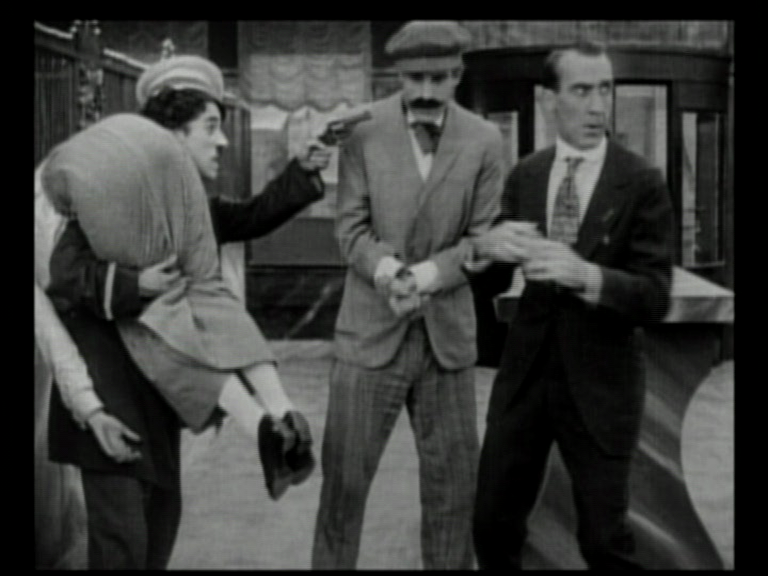Denis Condon’s blog Early Irish Cinema looks back at the early development of cinema in Ireland on the anniversaries of those developments and offers information on what cinemagoers could have seen in Irish cinemas a century ago. Here Denis looks at how cinema was becoming the nation’s entertainer.

Arthur Balfour, “Cabinet Minister as Cinema-Lecturer,” touts the importance of war films;Bioscope 6 Jan. 1916: 16.
On 29 December 1915, Arthur Balfour, Britain’s First Lord of the Admiralty, attended a screening of the war film Britain Prepared (Britain: Urban, 1915) at London’s Empire Theatre, Leister Square. “[T]these pictures constitute something more than an afternoon’s amusement,” he asserted. “They contain a lesson of the deepest import to us and the world” (“Britain’s Might Revealed”). The trade journal Bioscope was delighted with Balfour’s comments before the screening, drawing attention to them in a prominent article in its first 1916 issue. “This is, we believe, the first time in the history of the cinematograph that a Cabinet Minister has made a formal speech of introduction at an exhibition of moving pictures,” it claimed, “and as such it is an event of no small significance.” The Bioscope of 20 January clarified the magnitude of its significance, when it declared that cinema was now – finally – “The Nation’s Historian”:
The Trade has just cause for pride and gratification in the complete unanimity with which Press and public, Cabinet Minister and man-in-the-street alike, have welcomed the official cinematograph pictures of the war and the life and training of our soldiers and sailors. It has, we admit, taken a very long time to convince the Government and the Fourth Estate of the value of the cinematograph as the national historian, but now that their approval is forthcoming and the work pronounced to be good, we can well afford to regard the time as well spent. (“Nation’s Historian.”).
Doubtless Balfour’s endorsement of Britain Prepared was a valuable governmental recognition of the British film industry, and as such it is an important historical document. It is more doubtful that a film clearly conceived as propaganda – showing how Britain had prepared and was prepared to fight its enemies – can be considered a work of history. Nor was the Bioscope really interested in making a case for the film as history; it was enough of an achievement that Balfour’s presence and words showed how useful cinema had become to the war effort.

David Lloyd George and Henry Asquith feature in this ad for Metro Pictures; Dublin Evening Mail 3 Jan. 1916: 5.
While Balfour argued that Britain Prepared was not mere entertainment but a film that British politicians should take seriously, one distribution company suggested that two other Cabinet ministers were watching its films for relaxation. In January 1916, theDublin Evening Mail carried a series of ads placed by Ruffell’s, British agents for US production and distribution company Metro Pictures. The ads featured the Ruffell’s mascot, a parrot in a top hat, and in the first of these ads – which is in comic-strip form – the parrot convinces Minister for Munitions David Lloyd George and Prime Minister Henry Asquith to watch a Metro film as a needed break from their war duties. The incongruity of the images of these senior politicians visiting a cinema with the behatted and cigar-chewing parrot might distract from the no-less significant if admittedly less spectacular incongruity of this and other ads appearing in an Irish daily newspaper. Distribution was a wholesaling business; it acted as the intermediary between the manufacturers – film production companies such as Metro – and the retailers – the cinema-owners who actually showed the films. In the ordinary course of business, a distribution company such as Ruffell’s would advertise in such cinema trade journals as the Bioscope but not in the dailies. Ruffell’s did advertise in the trade press, but this series of ads sought to create recognition among cinema-goers of the relatively new Metro brand name and of the Ruffell’s parrot.

Official war film British Army in France at the Provincial Cinematograph Company’s Dublin picture houses. In the fist half of this week, the Grafton had shown With the Indian Troops in France. Dublin Evening Mail, 20 Jan. 1916: 5.
And the parrot was right: cinema was more likely the nation’s – or the world’s – entertainer than its historian. Amusement was the primary reason that Irish patrons visited a picture house, even if they did also come for other reasons, including to see how the war that they mostly read about in newspapers actually looked, and to cheer or to boo at a film that sought to use such images to engender patriotic feelings towards a nation that was invariably Britain. Nonetheless, the notion of the cinema as national historian had particular resonances for Ireland in 1916, as it has in 2016 as the country commemorates 1916. The experience of the more than 200,000 thousand Irishmen in the British armed forces were, of course, represented to some extent by Britain Prepared and other propaganda films that were appearing in increasing numbers. The Picture Houses in Grafton Street and in Sackville/O’Connell Street, which were owned by the British chain Provincial Cinematograph Theatres, made a particular feature of these films, promoting them with prominent illustrated ads, such as the one for British Army in France on 20 January. The Bioscope quoted Balfour as regretting that Britain did not “have a permanent record of the grand deeds of our armies in France and Flanders” (“Britain’s Might Revealed”). A number of such films did exist, but filmmakers would answer this call for a permanent record most spectacularly later in the year in the form of the film The Battle of the Somme (Britain: British Topical Committee for War Films, 1916).
As one of the main purposes of such films was to show the unity of kingdom, they could not represent the motives of Irish nationalists, who had to look elsewhere for elements of an Irish historical experience on film. This was clearly so in the case of the separatist nationalists who sought Irish independence from Britain and opposed recruitment, but it also included the many more moderate Irish nationalists, even soldiers who had joined the war in answer to John Redmond’s call to fight for Home Rule. Nationalist MPs at Westminster ensured Ireland was treated as a special case even in relation to military recruitment, a fact emphasized in January 1916 when the Military Service Act excluded the country from the compulsory conscription. Given the paucity of film production in Ireland, there was little prospect of cinema providing a detailed film record of the struggle for Irish national self-determination. The nearest thing to such a film was Ireland a Nation (US: Macnamara, 1914), shot in Ireland in 1914 but not shown in the country until 1917. Newsreel films of armed National and Irish Volunteers parading do exist, albeit that the Ulster Volunteers were better at media management, including arranging for cinematograph operators to record significant demonstrations. Fiction films representing Ireland’s rebellions in 1798 and 1803 had been made by US companies such as Domino and Kalem, Sidney Olcott shooting many Irish-shot films for the latter. The special Sunday shows at Dublin’s Phibsboro Picture House on 23 January featured For the Wearing of the Green (US: Domino, 1914), in which “Paddy Dwyer, the Irish blacksmith, and his helper, Dennis Grady, who is also his daughter Norah’s sweetheart, are the prime leaders in the conspiracy against the Crown” (“Domino”). The Hibernian Electric Theatre’s Sunday feature a week later was Olcott’sThe Mayor from Ireland (US: Kalem, 1911), in which two Irish immigrants follow each other in the office of New York mayor. Neither of these films was a new release, but their revival suggests their importance for Irish audiences in offering fictional self-representations that included revolutionary romances.

Ad for Hibernian, Evening Telegraph 29 Jan. 1916: 1.
Indeed, the Hibernian Electric Theatre may provide one of the most direct links between Irish cinema and the revolution that was being planned for 1916. This picture house at 113 Capel Street, Dublin, had previously been called the Irish Cinema and had been owned and run by Richard Graham. Financial difficulties including rent default forced Graham to sell in late 1915 (“Capel Street Picture House”). No account of the reopening as the Hibernian appears to exist, but it was advertising in the Evening Telegraph by the start of January. The ads and short notices that month give an indication of some of the people involved, including manger Thomas Fullam and musical director Miss M. Grundy (“Hibernian Electric Theatre”). It is possible that it was owned or part owned by Michael Mallin, as later recalled by his son (Hughes 76-78.). Dublin silk weaver, British Army bugler, union organizer and leader of the Irish Citizen Army, Mallin would be executed in May 1916 for his role in the Easter Rising. How his picture-house experience may have had a bearing on his revolutionary activity or vice versa is difficult to say. Nevertheless, the Hibernian was located beside the Trades Hall – a fact noted in ads – and it is likely that its programming aimed to attract union members, as well as the many working class people who lived in the slum districts that would have been the catchment area for the cinema’s audience. In 1913 and 1914, the Irish Cinema had been the only picture house and one of the few entertainments of any kind that advertised in the radical labour journal The Irish Worker. However, apart from The Mayor from Ireland, its offerings seem little different from those of other Dublin picture houses.

Irish Independent 4 Jan. 1916: 4.
If Irish picture-house owners – even radical ones – had only moulded cinema in limited ways to produce a national moving image, religious groups were working more deliberately to ensure that cinema reflected the churches’ worldview. This was particularly the case with Catholic groups, such as the Dublin Vigilance Committee, which in December 1915 had coalesced with other vigilance groups around the country to become the Irish Vigilance Association (IVA). Following his arrest on 31 December 1915, serial cinema protester and militant IVA member William Larkin was released from Dublin’s Mountjoy Jail on 4 January 1916. He had been imprisoned for non-payment of the fine imposed on him in October and November for his protest at the Bohemian Picture Theatre in September (“Picture Theatre Protest”). The IVA arranged a parade of welcome from Larkin’s house in Sherrard Avenue in the north city to Foster Place, a favoured place to hold speeches beside the city-centre building that had until 1800 had been the Irish parliament. Larkin’s short prison term had done nothing to lessen his activism on the introduction of film censorship; indeed, it allowed him to claim a certain martyrdom. “I was treated as a low criminal in Mountjoy Jail for protesting against a film,” he claimed in an exchange of correspondence published by the Evening Telegraph. “I had to don a convict’s garb, eat skilly, lie on a board, and refuse hard bread. I had to parade with degenerates in a prison yard; and all, that our youth might be spared gazing on suggestion” (“Proposed Cinema Censorship”).
This concern with young people also prompted calls for censorship from reformers seemingly unaligned with the IVA. In a letter to the Telegraph, E. Gordon urged regulation of picture houses to prevent children from attending late evening shows. “I have seen toddlers and youngsters, aye, and smoking cigarettes (another Dublin byelaw more honoured in the breach than the observance) in picture houses at 10.30 p.m,” he observed:
Where did they get the money, and where were their homes? Where were their parents? Why are those children allowed to spend their lives thus? Perhaps the housing question would account for a lot of it. Now, those youngsters go in to a picture house (“It’s only tuppence, Billy”). They do not go in to look at a moral lesson faithfully learned, or for education – only for a laugh, and “it’s comfey.” (“Children at the Cinema.”)
Gordon wished for an educational cinema, recognizing it as “a great, wonderful and fascinating optical achievement (if directed in the proper channel) that was never dreamt of twenty years ago.” As such, it was an “accomplishment which makes old lanternists blush, and yet their blush can be condoned, for the old scientific lantern will still hold its own, at least in the class-room and lecture hall.”
In the Dublin township of Rathmines, the ongoing controversy on the opening of picture houses on Sunday continued into early 1916. At a meeting on 5 January, the council eventually split 8-8, and the chairman cast the deciding vote in favour of closing cinemas on Sundays; they had had limited opening hours before this. Councillor Thomas Kennedy spoke in favour of keeping them open, reading a supporting letter from the Ratepayers’ Protection Association that argued that soldiers’ relatives particularly liked seeing war reports and that closing cinemas on the only day when many people could visit them would drive these people to the pubs for recreation. Rejecting such arguments, Chairman Sibthorpe explained that he had cast his vote in favour of Sunday closing because oculists had “stated that their work had been more than doubled since these cinemas had been applying a violent stimulant to the eyes of the young people, and they were absolutely ruining the sight of the rising generation” (“Cinema Shows”).
Young people who got into trouble with the law – and their legal representatives – were well aware of these discourses on cinema’s pernicious effects on the young and of how to use them to their advantage. When “two young fellows” named Richard Barnes and Thomas Farrell appeared before Mr. Swifte at Dublin’s Southern Police Court on 27 January 1916, their solicitor argued that they had entered a banana store illegally because of watching burglaries at the picture houses and playing slot machines (“Cinema and Slot Machines”). These new forms of popular culture “were the means of leading many a young fellow astray,” he argued.

Chaplin foils a robbery in Charlie at the Bank (US: Essanay, 1915).
The person responsible for a good amount of this violent visual stimulation in Ireland in 1916 was Charlie Chaplin, but in January 1916, he was foiling robberies rather than committing them. The writer of the Evening Telegraph’s “Gleaned from All Sources” column, however, had picked up the news that Chaplin’s career was on the wane, “which is the obvious and inevitable result of overdoing the Chaplin ‘boom.’ When it came to imitations in music-hall revues and Charlie Chaplin calendars and pin-cushions,” s/he observed, “a reaction was inevitable.” Despite merchandizing and overexposure, that reaction was not apparent in Dublin picture houses, according to the review writer in the same issue of the Telegraph. Charlie at the Bank had recently been released, and the reviewer was assessing the show at the Pillar Picture House. “There is more riotous fun packed into this two-reel comedy than any other photo-play of a like length. The world’s great comedian, Charlie Chaplin, has outdone himself in this new production. While all his other comedies are funny, this one is a scream. It abounds in real humour and comic situations, with Chaplin at his best in his inimitable antics” (“Pillar Picture House,” 18 Jan.). Charlie at the Bank was shown at more picture houses than any other film that month, suggesting that cinema-owners did not believe that Chaplin’s career was experiencing a dip. Audiences seemed to agree: on account of the “hundreds who could not gain admission” during the three day run, the film was held over for a further three days (“Pillar Picture House,” 20 Jan.).
As 1916 began, Irish audiences enjoyed a thriving cinema culture that more often offered them a violent stimulant of the Chaplin kind than national history.
Denis Condon lectures in film at NUI Maynooth.
Contact: denis.j.condon@nuim.ie
References
“Britain’s Might Revealed by Film: A Cabinet Minister as Cinema-Lecturer.” Bioscope 6 Jan. 1916: 16A.
“Children at the Cinema.” Evening Telegraph 8 Jan. 1916.
“Cinema and Slot Machines.” Dublin Evening Mail 27 Jan. 1916: 5.
“Cinema Shows: Sunday Performances in Rathmines: Action of Urban Council.”Evening Telegraph 5 Jan. 1916: 5.
“Domino: The Wearing of the Green.” Moving Picture World 3 Mar. 1914: 1302.
“Dublin and District: Picture Theatre Protest.” Irish Independent 1 Jan. 1916: 6.
“Gleaned from All Sources: The Late Charlie Chaplin.” Evening Telegraph 18 Jan. 1916: 1.
“Hibernian Electric Theatre.” Evening Telegraph 29 Jan. 1916: .
Hughes, Brian. Micheal Mallin. Dublin: O’Brien Press, 2012.
“The Nation’s Historian: Triumphant Vindication of the Cinematograph.” Bioscope 20 Jan. 1916: 229.
“Pillar Picture House.” Evening Telegraph 18 Jan 1916: 5; 20 Jan 1916: 5.
“Proposed Cinema Censorship.” Evening Telegraph 11 Jan. 1916: 3.




